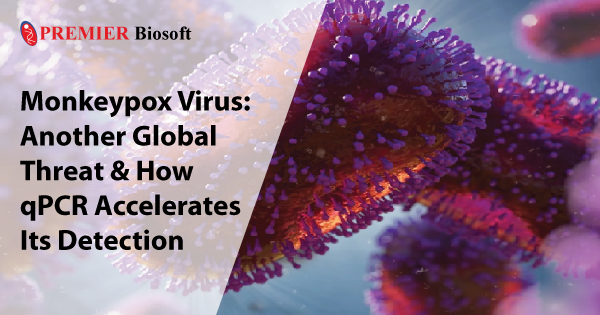Home >> Blog >> Monkeypox Virus: Another global threat and how Real-time PCR accelerates its detection
Monkeypox Virus: Another global threat and how Real-time PCR accelerates its detection

November 22, 2022
The world has witnessed the fierce COVID-19 pandemic resulting in 6.4 million deaths worldwide. While recovering from the socioeconomic disruption, the Monkeypox outbreak is posing another threat to the world. The World Health Organization (WHO) has recognized it as a public health emergency of international concern (PHEIC).
Human Monkeypox Virus (MPXV) is a double-stranded DNA virus belonging to the family Poxviridae, and genus Orthopoxvirus. At the State Serum Institute in Copenhagen (Denmark), it was initially determined that it was the root of pox like sickness in the confined monkeys. The first human case of monkeypox was identified in 1970 in a 9-month-old boy from the Democratic Republic of the Congo (formerly Zaire). So far, two genetic clades of Monkeypox Virus have been identified: West African and Central African (Congo Basin). The Congo Basin clade is found more pathogenic than the West African Basin clade.
How Monkeypox transmits?
MPXV follows two ways of transmission:
1. Animal-to-human (zoonotic) - Direct contact with blood, body fluids, or cutaneous or mucosal lesions of infected animals results in animal to human transfer.
2. Human-to-human transmission - Close contact with respiratory secretions, skin sores or an infected person, or recently contaminated objects can cause human to human transfer. Although close physical contact is a well defined risk factor for the transmission, it is unknown if sexual contact can spread monkeypox virus.
Monkeypox Replication and Incubation
After entering humans (CD14+ cells), MPXV immediately begins replication in the cytoplasm of an infected cell. In the cytoplasm, viral factories help in the formation of mature virions (MVs). MVs remain dormant until they are transported to the Golgi apparatus, where they are wrapped in two more lipid layers to create extracellular viruses (EVs). EVs are the primary factor causing the spreading of viruses throughout the body of the host.
MPXV has a 13-21 day incubation period, and fever is the first symptom to appear after the first two weeks of infection, followed by lymphadenopathy and skin lesions.
How Real-time PCR detects Monkeypox Pathogenesis?
Laboratory identification is important because the virus can cause illness that is clinically difficult to identify from other pox viruses. Real-time PCR has become an essential diagnostic and monitoring option in recent monkeypox epidemics, due to the advantages of the quick, high-throughput, and better sensitivity for the diagnostics. Swabs from MPXV patients' skin lesions were delivered to the lab under aseptic conditions for pathogen detection using real-time PCR. Standard TaqMan and TaqMan MGB assays are found to be the most effective techniques.
An MPXV-specific TaqMan assay appears challenging and is likely to provide false-positive results because the Monkeypox genome is almost 90% identical to other Eurasian orthopoxviruses and its GC content is low. Therefore, to increase specificity, an MGB probe that targets the specific gene (B6R, C3L, etc.) of MPXV was developed, and it exhibits promising 100% specificity towards both the MPXV clades.
Informatics Support for Highly Specific MGB Probe Design
Manual analysis of the entire genome to identify a suitable set of MGB probes and compatible primer pairs is resource and time intensive. Moreover, designing species-specific MGB oligos is tricky, as it requires aligning the Monkeypox virus genome with other Eurasian orthopoxviruses, and designing the oligos over the unique regions of the aligned target sequences. The life science research community is in dire need of informatics support that facilitates the rapid designing of MGB assays. AlleleID® is a software tool that supports aligning multiple target sequences and designing species-specific assays or taxa-specific assays over the unique region and the conserved region respectively. The software is also equipped with multiple advanced features that ensure the high specificity of the designed oligos. A couple of them are:
1. Template structure search: This feature identifies the regions of the target sequence that may form any secondary structure at the reaction temperature. These regions are automatically avoided for oligo design
2. Built-in BLAST search: AlleleID facilitates aligning the target sequences against any genome to find the homology. The homologous regions in the target sequence can be avoided for oligo design.
The software supports designing oligos for other major real-time PCR chemistries, such as Molecular Beacon, SYBR Green, etc. To learn more about AlleleID, please click here.
| Comment | Share |
|


